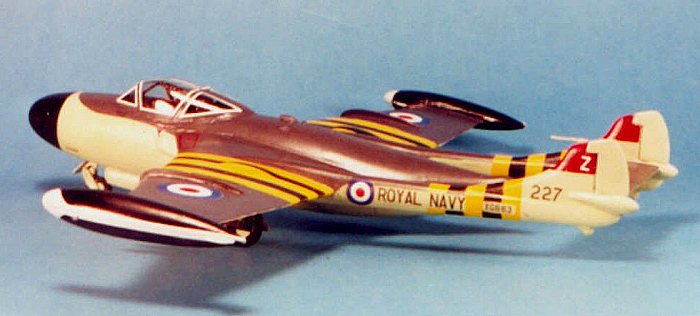
Aeroclub 1/48 Sea Venom
|
KIT # |
|
|
PRICE: |
$52.95 |
|
DECALS: |
See Review |
|
REVIEW : |
|
|
NOTES: |
Multimedia vacuform kit |

|
HISTORY |
Operation Musketeer Continued: The Fleet Air Arm (Part 1)
Operation Musketeer was the last large-scale action involving the Royal Navy's aircraft carrier force. Three carriers, H.M.S. Albion, Bulwark and Eagle, constituted the air component of the Royal Navy's contribution to the planned intervention.
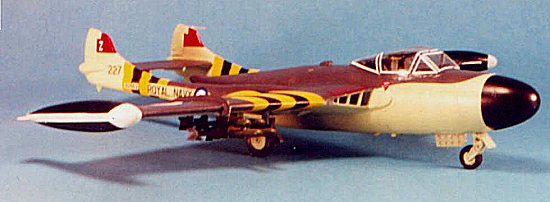 Aboard the three carriers were DeHavilland Sea Venom FAW Mk. 21 all-weather
fighters from 809 Squadron (H.M.S. Albion), 892 Squadron (H.M.S. Eagle)
and 893 Squadron (H.M.S. Bulwark). The squadrons were tasked with
providing night and bad weather air defense for the Anglo-French fleet, and as
strike aircraft for daylight operations over Egypt. Though unstated, one of the
tasks of the Sea Venoms was to provide early warning of any possible
intervention by the U.S. Sixth Fleet, units of which were shadowing the
Anglo-French ships from north of Cyprus.
Aboard the three carriers were DeHavilland Sea Venom FAW Mk. 21 all-weather
fighters from 809 Squadron (H.M.S. Albion), 892 Squadron (H.M.S. Eagle)
and 893 Squadron (H.M.S. Bulwark). The squadrons were tasked with
providing night and bad weather air defense for the Anglo-French fleet, and as
strike aircraft for daylight operations over Egypt. Though unstated, one of the
tasks of the Sea Venoms was to provide early warning of any possible
intervention by the U.S. Sixth Fleet, units of which were shadowing the
Anglo-French ships from north of Cyprus.
The Sea Venoms first entered combat on November 1, 1956, with a surprise attack on Egyptian airfields in the canal zone. 893 Squadron destroyed a number of MiG-15s at Almaza airfield near Cairo, while the other two squadrons shot up other fields nearby. The ineffectiveness of the Egyptian Air Force meant the Sea Venom had no opportunity to display its air combat capabilities.
During the six days of Operation Musketeer, the Sea Venoms provided Fleet CAP against possible attacks that never materialized. The three squadrons made numerous low level strikes in the Canal Zone using cannon fire and rockets against airfields and other targets. They also provided top cover for the landings at Port Said on November 3. During this operation, LCDR R.A. Shilcock, CO of 893 Squadron strafed and sank an Egyptian E-boat. The squadrons performed "cab rank" attacks against targets of opportunity such as tanks, mortar batteries and vehicles.
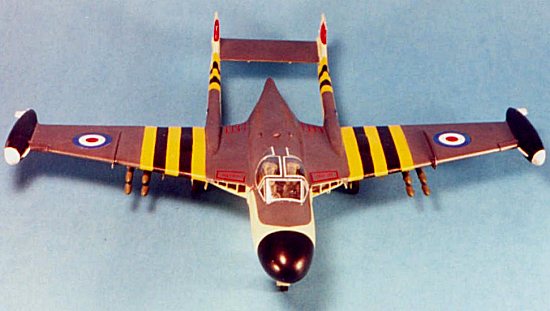 During the operation, only one Sea Venom was lost, with WW281 of 893 Squadron
making an emergency wheels-up landing aboard Eagle, during which it
became the first aircraft to be saved by the ship's nylon deck barrier, though
it was damaged beyond repair in the process.
During the operation, only one Sea Venom was lost, with WW281 of 893 Squadron
making an emergency wheels-up landing aboard Eagle, during which it
became the first aircraft to be saved by the ship's nylon deck barrier, though
it was damaged beyond repair in the process.
Following the cease-fire proclaimed on November 6, Sea Venoms remained with the fleet to cover the withdrawal of British forces from Port Said, then sailed for Malta.
The Airplane:
A DeHavilland Vampire became the first jet in history to land aboard a carrier, when LCDR Eric Brown landed the second prototype Vampire aboard HMS Ocean on December 3, 1945. The Fleet Air Arm's interest in the Vampire - which had just entered full production for the RAF - was more as a way of becoming familiar with the problems of operating jets from carriers than any intrinsic interest in the Vampire as a combat aircraft.
In 1947 the Vampire was upgraded with a Ghost engine developed from the original Goblin. Making use of the 50 percent increase in power meant airframe modifications, which resulted in the Venom. The Royal Navy became very interested in a DeHavilland proposal for an interim night fighter developed from the Venom using the 2-seat cockpit and radar developed for the Vampire night fighter. This design also became the RAF Venom NF Mk.2. Designated the Sea Venom NF Mk. 20, the airplane first flew April 19, 1951, with the first fully-navalized version flying on July 26, 1952; this was different from the first two prototypes in having power-folding wings. 60 aircraft, designated FAW (Fighter, All-Weather) Mk. 20 were ordered that August, with 890 Squadron becoming the first fully-equipped Sea Venom unit in March 1954.
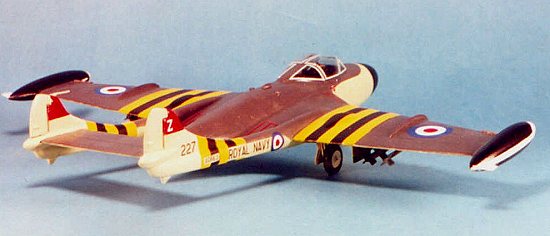 The Royal Australian Navy ordered 49 Sea Venoms in 1952, with 39 finally
delivered as Sea Venom FAW Mk. 53 between March and December 1955. These
aircraft would serve aboard HMAS Melbourne until 1968. I remember seeing
these aircraft over Sangley Point Naval Station in Manila in May 1963, following
the end of that year's SEATO exercise. (Even then I was well-known as an
aircraft spotter; no one else could identify the airplanes, so the squadron XO
made a $5 bet I could identify them, which I promptly did.)
The Royal Australian Navy ordered 49 Sea Venoms in 1952, with 39 finally
delivered as Sea Venom FAW Mk. 53 between March and December 1955. These
aircraft would serve aboard HMAS Melbourne until 1968. I remember seeing
these aircraft over Sangley Point Naval Station in Manila in May 1963, following
the end of that year's SEATO exercise. (Even then I was well-known as an
aircraft spotter; no one else could identify the airplanes, so the squadron XO
made a $5 bet I could identify them, which I promptly did.)
Difficulty with weak landing gear and tail hooks led to the Mk. 20 order being reduced to 50, with the last ten strengthened and equipped with Martin-Baker Mk.2 ejection seats, a bulged canopy over the pilot's seat to facilitate view during landing, and US APS-57 radar. They became the FAW Mk.21, the most-produced variant with 168 aircraft total. Those later aircraft in the XG-range were equipped with the lightweight Martin-Baker Mk.4 seat. The final version, the FAW Mk.22 which appeared in late 1956, had an uprated Ghost 104 engine which resulted in increased climb. 39 were produced, and another 40 Mk. 21s were upgraded to Mk.22 standard.
1957 saw the Sea Venom equipping four FAA squadrons: 890, 892, 893 and 894, all aboard carriers. In 1958, the FAW Mk.22 aircraft were modified to carry Firestreak missiles. The Sea Venom left first line FAA service in 1961 with the disbandment of 894 Squadron. The Sea Venom was followed into service by the Sea Vixen, a development of the D.H.110 that had been considered by the FAA before adoption of the Sea Venom; the protracted development of this type is why the Sea Venom was considered an "interim" all-weather interceptor.
|
THE KIT |
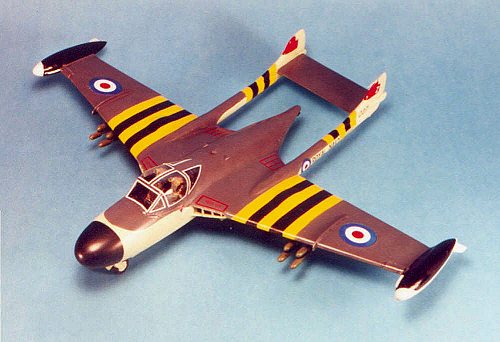 Aeroclub's multi-media Sea Venom first came out four years ago, and is the
only 1/48 kit of this airplane ever produced. Frog made a 1/72 kit in the early
70s with markings for a FAA FAW 22, and an Australian FAW 53.
Aeroclub's multi-media Sea Venom first came out four years ago, and is the
only 1/48 kit of this airplane ever produced. Frog made a 1/72 kit in the early
70s with markings for a FAA FAW 22, and an Australian FAW 53.
The kit features a vacuformed wing/rear fuselage, with limited-run plastic for the forward fuselage, booms, tail surfaces and wingtip tanks, and the usual Aeroclub white metal detail parts. There are two vacuformed canopies, something I was happy to have when I managed to step on one of them. Decals are provided for an Australian FAW Mk. 53, and a FAA FAW Mk.22 of 894 Squadron in 1960, with a good looking sharkmouth insignia. Unfortunately, there are no markings provided for any aircraft that participated in Operation Musketeer.
|
CONSTRUCTION |
The first thing I did was sand down the vacuformed wings, and cut open the landing gear wells. I glued in the white metal landing fear well walls and the jet exhaust assembly, and glued the vacuform pars together. I then cleaned up and assembled the limited-run plastic parts. I put weight in the nose, glued in the plastic floor and fore and aft cockpit bulkheads, then glued the nose together and glued this to the wing/rear fuselage sub-assembly. I then attached the white metal air intakes, followed by the tail booms and horizontal stabilizer. Each of these operations involved a fair amount of test fitting, cutting and filing to get a good fit. Once everything was glued together, I puttied all joints and seams and set the model aside.
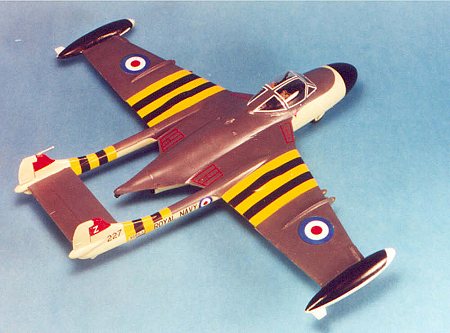 There was a lot of sanding and filing and re-puttying to get a smooth finish.
Once this was done, I went to assemble to cockpit. I had waited to do this since
the layout was such that it did not need assembly prior to gluing the nose
together. I had obtained two KMC Martin-Baker seats originally made for the
Academy Hunter. The Mk.2 seat is not that obviously different from the Mk.4,
which these are. I had to sand off side detail so they would fit together
side-by-side in the cockpit, but this was a small price to pay for seats that
looked much better than what I would have had with the white metal seats that
came with the kit. The cockpit was painted black overall, while the seats were
painted according to the KMC instruction sheet. I then took the canopy, which
had been cut clear of its base and dipped in Future, and attached it. It was
clear enough that the cockpit interior could be seen clearly with the canopy
closed; opening the canopy involved an assembly that looked like it would be
quite fragile when completed.
There was a lot of sanding and filing and re-puttying to get a smooth finish.
Once this was done, I went to assemble to cockpit. I had waited to do this since
the layout was such that it did not need assembly prior to gluing the nose
together. I had obtained two KMC Martin-Baker seats originally made for the
Academy Hunter. The Mk.2 seat is not that obviously different from the Mk.4,
which these are. I had to sand off side detail so they would fit together
side-by-side in the cockpit, but this was a small price to pay for seats that
looked much better than what I would have had with the white metal seats that
came with the kit. The cockpit was painted black overall, while the seats were
painted according to the KMC instruction sheet. I then took the canopy, which
had been cut clear of its base and dipped in Future, and attached it. It was
clear enough that the cockpit interior could be seen clearly with the canopy
closed; opening the canopy involved an assembly that looked like it would be
quite fragile when completed.
|
PAINT & DECALS |
Painting:
I first painted the model light grey overall to insure all seams and joins had been filled. I was in luck on that, and proceeded with pre-shading the panel lines with flat black. I followed this up by painting the black and yellow Operation Musketeer stripes, first airbrushing Tamiya Flat Yellow, then masking off the stripes and airbrushing the black stripes. With all this masked off, I painted the lower fuselage with Gunze-Sanyo "Sky," which I think is closer in color to post-war FAA "Sky" than the Tamiya "Sky" I use for WW2 aircraft, and painted the upper surfaces with Tamiya Dark Sea Grey. The tip tanks were painted white, then masked off, and painted black for the squadron markings of 890 Squadron.
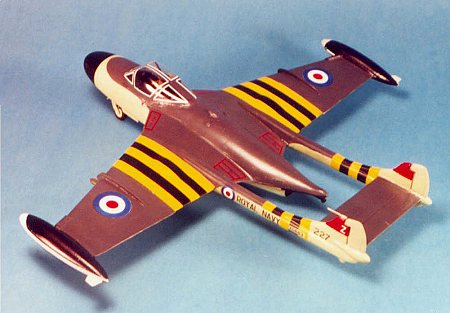 Decals:
Decals:
By transposing the serial numbers for the 894 airplane in the kit decals, I was able to do an 890 Squadron airplane that participated in Operation Musketeer, which was delivered to the squadron shortly before the event and did not have the squadron insignia painted on the nose (a nice way of getting around the fact there are no decals of this available and it's too hard to hand paint, at least for me). I used ModelDecal RAF Type D roundels, which are the right color of both blue and red for post-war British roundels. I cut some white decal sheet to make the strips of sealer around the canopy glass. When all was finished, I applied another light coat of Future to seal the model.
Final Assembly:
I attached the white metal landing gear and gear doors, and then attached a set of rockets from the Airfix Spitfire 22/24 kit.
Overall:
I had a lot of fun doing this model. It was the first vacuform I have done in a couple of years, and it was good to refresh those skills. I have gone on to finish an Aeroclub Meteor NF 14 mixed-media vacuform and am working on a Falcon Supermarine Swift and a Tom's Modelworks Sopwith Strutter, which are both older vacuforms without the "mixed-media" component. Many modelers shy away from this kind of kit, but to me they present more of a challenge than do even Eastern European limited-run injection molded kits, with a nice sense of accomplishment when the model is finally sitting on the shelf. It's for sure that if you like early jets, you won't find Tamiya or Hasegawa doing this one anytime soon.
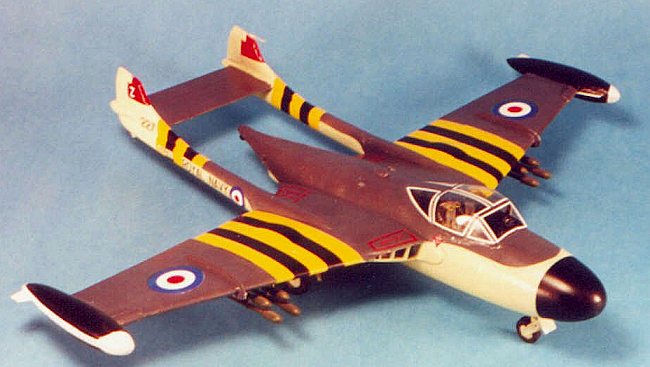
Copyright ModelingMadness.com
Thanks to Aeroclub for providing the review copy.
If you would like your product reviewed fairly and fairly quickl, please contact the editor or see other details in the Note to Contributors.
Back to Reviews Page 2017